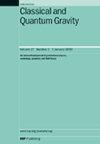Holographic phenomenology via overlapping degrees of freedom
IF 3.6
3区 物理与天体物理
Q2 ASTRONOMY & ASTROPHYSICS
引用次数: 0
Abstract
The holographic principle suggests that regions of space contain fewer physical degrees of freedom than would be implied by conventional quantum field theory. Meanwhile, in Hilbert spaces of large dimension 2n, it is possible to define Pauli algebras that are nearly anti-commuting (but not quite) and which can be thought of as ‘overlapping degrees of freedom’. We propose to model the phenomenology of holographic theories by allowing field-theory modes to be overlapping, and derive potential observational consequences. In particular, we build a Fermionic quantum field whose effective degrees of freedom approximately obey area scaling and satisfy a cosmic Bekenstein bound, and compare predictions of that model to cosmic neutrino observations. Our implementation of holography implies a finite lifetime of plane waves, which depends on the overall UV cutoff of the theory. To allow for neutrino flux from blazar TXS 0506+056 to be observable, our model needs to have a cutoff . This is broadly consistent with current bounds on the energy spectrum of cosmic neutrinos from IceCube, but high energy neutrinos are a potential challenge for our model of holography. We motivate our construction via quantum mereology, i.e. using the idea that EFT degrees of freedom should emerge from an abstract theory of quantum gravity by finding quasi-classical Hilbert space decompositions. We also discuss how to extend the framework to Bosons. Finally, using results from random matrix theory we derive an analytical understanding of the energy spectrum of our theory. The numerical tools used in this work are publicly available within the GPUniverse package, https://github.com/OliverFHD/GPUniverse.通过重叠自由度的全息现象学
全息原理表明,空间区域所包含的物理自由度比传统量子场论所暗示的要少。同时,在维度为 2n 的大希尔伯特空间中,有可能定义出几乎反交换(但不完全反交换)的保利数列,这些数列可被视为 "重叠自由度"。我们建议通过允许场论模式重叠来模拟全息理论的现象学,并推导出潜在的观测结果。特别是,我们建立了一个费米量子场,其有效自由度近似服从面积缩放并满足宇宙贝肯斯坦约束,并将该模型的预测结果与宇宙中微子观测结果进行比较。我们的全息实施意味着平面波的有限寿命,这取决于理论的整体紫外截止。为了能够观测到来自耀星 TXS 0506+056 的中微子通量,我们的模型需要有一个 .这与目前冰立方(IceCube)对宇宙中微子能谱的约束大体一致,但高能中微子对我们的全息模型是一个潜在的挑战。我们通过量子纯理论(quantum mereology)来激发我们的构造,即利用 EFT 自由度应该通过寻找准经典的希尔伯特空间分解而从量子引力的抽象理论中产生的想法。我们还讨论了如何将框架扩展到玻色子。最后,利用随机矩阵理论的结果,我们得出了对我们理论能谱的分析理解。这项工作中使用的数值工具在 GPUniverse 软件包 https://github.com/OliverFHD/GPUniverse 中公开提供。
本文章由计算机程序翻译,如有差异,请以英文原文为准。
求助全文
约1分钟内获得全文
求助全文
来源期刊

Classical and Quantum Gravity
物理-天文与天体物理
CiteScore
7.00
自引率
8.60%
发文量
301
审稿时长
2-4 weeks
期刊介绍:
Classical and Quantum Gravity is an established journal for physicists, mathematicians and cosmologists in the fields of gravitation and the theory of spacetime. The journal is now the acknowledged world leader in classical relativity and all areas of quantum gravity.
文献相关原料
| 公司名称 | 产品信息 | 采购帮参考价格 |
|---|
 求助内容:
求助内容: 应助结果提醒方式:
应助结果提醒方式:


